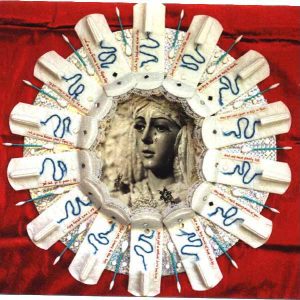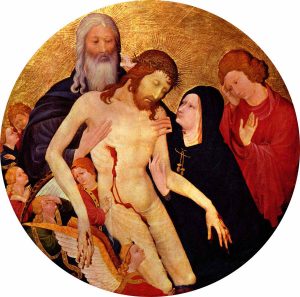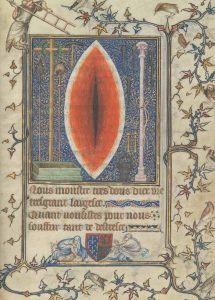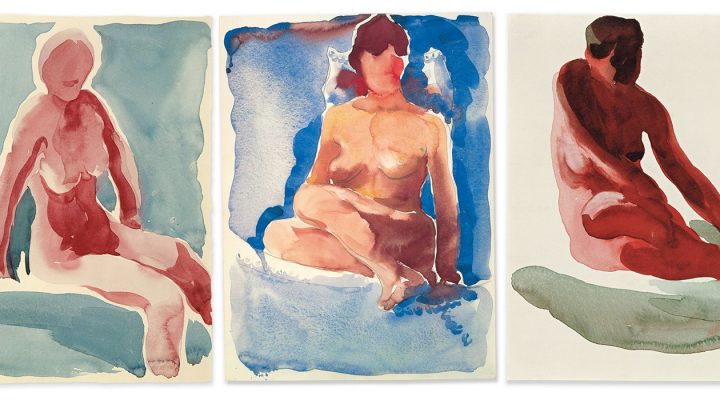This is the first in a four-part series of Advent reflections by Julia Goldie Day that will run on Mondays.
Ever hear the phrase, “Behind every successful man, there is a woman?”
Jesus is the successful man; Mary is the woman.

“Mary, Mary” by P.J. Speakman. Museum of Menstruation and Women’s Health
Mary is an enigmatic figure. She has been used and abused to subjugate women, to keep women under control, under the thumb of the Christian church for centuries. Women must spend most of their early lives birthing and then nursing children. Often denied birth control methods, raising multiple children, caring for husband and households, carrying the emotional load, making sure the world runs like it should while expected to smile demurely — we should look to Mary as an obedient example.
Like Mary, either perpetual virgin or perpetual mother seems to be the only choice for women. We stay single and chaste or raise children, we help and support men, we stay in our place, and Mary stays in her place in the background, behind Jesus.
More than half our churches are comprised of women. Yet in our church pulpits and our platforms we see mostly men. When women do have a chance to lead in churches, they are at a steep disadvantage. And many women in the pews don’t even realize they have only heard the gospel from a male perspective for most of their lives because Mary stays hidden away.
 Mary is the hero of her own story, of God’s story, and she gets sent to the corner or just ignored entirely. This is the real “war” on Christmas — that we have not seen Mary in her own story.
Mary is the hero of her own story, of God’s story, and she gets sent to the corner or just ignored entirely. This is the real “war” on Christmas — that we have not seen Mary in her own story.
Before Mary, only one time in Scripture is a woman given credit for her own offspring. Mary begets Jesus. I should hope so; Joseph did not contribute sperm. Men are used to getting all the credit.
As a woman myself, I am more cognizant that Mary was a real flesh-and-blood woman. This means she was an enfleshed woman who bled monthly. I am guessing few preachers or Bible commentaries spend much time talking about Mary’s period because, well, they would get fired.
Let us think about why that is. We have been trained by our culture for centuries, thousands of years even, that menstrual blood is taboo, it is unclean. This taboo of menstrual blood begins in the Bible. According to the Old Testament, we know even blessed Mary would not have been allowed to enter the temple while menstruating.
This impurity of women has come to be associated with sinfulness. There is something about the created order of woman that is “misbegotten,” that must be accounted for with power over by man. This feminine blood is tainted.
But we speak, read about, sing about the male blood of Jesus in church during Lent and Easter without batting an eye, do we not? Why is that different?

La Grande Pietà ronde, circa 1400. Louvre. Note the blood flowing from Jesus’ side. (Wikimedia)
In fact, Jesus has a vulva (vulva is the correct name for the anatomy commonly known as the vagina that contains the vaginal opening and the clitoris) or oval shaped wound in his side from which he “bled” like women bleed as he hung from the Cross and died.
While mostly unavoidable for women, menstruation is an essential monthly fertility ritual. It is the release of unused tissue that develops inside a person born female with a womb or uterus and is what will allow the zygote to attach to the uterine wall. Mary had menstrual tissue, a uterine wall and a uterus — all female anatomy that allowed her to become pregnant, to conceive.
Mary knew the acute pain of menstruation. She had endured and celebrated this strange rhythm of bleeding and pain that has deep meaning for us all, not just women.

Christ’s Side Wound, Psalter of Bonne de Luxembourg (Wikimedia)
Often in our Baptist churches we hear about the power of the blood or being washed in the blood. Blood is linked to baptism. For me, that is quite literal. Years ago, I had baptized a young girl in worship, she had time to dry her hair in the restroom and later return to worship, but I had to hastily change in a side room of the baptistry out of my wet white robe and undergarments, towel off, redress and quickly return to my seat on the platform to continue to lead in worship. The process was complicated by my period, but I managed. After worship, much to my chagrin I found that a male deacon had cleaned up my wet towel, robe and wet bloody underwear and placed them in a plastic bag for me to take home.
That God in infinite wisdom had chosen only an enfleshed menstruating woman for the advent of a new Eden is apt.
Blood is strength. Blood is power. Potential. New life. The womb and the blood that comes from it is distinctly creative.
In Luke’s Gospel, the angel says to Mary that she will conceive in her womb. The Holy Spirit, she will come upon you and somehow creatively act to make this be. Mary is troubled because she has not known a man intimately and says it does not work that way, right?
We should be careful not to miss that Mary is clearly less than naïve in how conception results in birth. Perhaps she knew the words of Songs of Songs chapter 3 verse 4 in which the female voice speaks of her mother’s bedchamber where she wishes to bring her own lover where she herself was conceived:
“Scarcely had I passed them, when I found him whom my soul loves. I held him and would not let him go until I brought him into my mother’s house and into the chamber of her that conceived me.”
While the ancient Palestinians may not have understood biology, they most certainly understood the outcome of human sexuality. Babies are created by humans engaging in sexual intercourse. The angel does not explain how Mary will conceive but goes on to say this child will be holy and the Son of God. This baby will not be conceived with sex, implying to many that the so-called “sin” of sexual activity will not be required. This baby will be conceived only with a woman. A man will not be needed.
Mary’s seed is conceived with God’s help, somehow, and not without scandal. It is not explained. The angel did not offer a virginal conception instruction book. Whatever is to come, this seed is to become someone holy and human. It was hard to believe what she had just heard.
But then a couple of weeks later, Mary missed her period.

Advertisement of Mary with a positive pregnancy test, from St. Matthew-in-the-City, an Anglican church in Auckland, New Zealand.
How we see Advent through the eyes, through the body of Mary, colors our experience anew:
Red blood for anger: Why must we continue to allow Mary to be whitewashed into submission? We often gravitate to images or art of Mary dressed in a shade of light blue rather than the deep red of blood. Why is Mary washed out and sent into the background of her own story? Silenced. Why would we allow ourselves and our daughters to be hidden away — shamed about what the female body does naturally? Maia Schwartz says, “Menstruation is the only blood that is not born from violence, yet it’s the one that disgusts you the most.” For this, oh God, we are filled with righteous anger. But we will remain.
Red blood of mourning: Blood also can be the loss of tissue that was a potential and hope for new life. If that is what you are currently experiencing or if this is a fresh wound for you, I hope you will feel some small comfort in the fact that you are seen, you are valued, you are loved and somehow you may be able to share more easily the sorrow you are experiencing in your loss. May the Mother God enfold you in her loving arms and give you peace. Please seek professional and medical assistance for your bodily and mental health.

“Special,” Georgia O’Keeffe, 916-1917 © Georgia O’Keeffe Museum
Red blood for renewal: With each month, each cycle, each Advent, we begin again with new chances to gain new understanding. Unlearning, relearning. Hearing the same stories again in a new light. May we be renewed by the blossoming of our minds. May our brains come alive, buzzing with synapses, possibilities, new ideas, new questions, led by Spirit-filled joy. Let it be with me.
Red blood of healing: Jesus healed an unnamed woman of a chronic uterine hemorrhage when she took the initiative to touch the hem of his cloak in a crowd which renders Jesus ceremoniously unclean. We should note this is the only time a healing happens unknown to the Messiah. Jesus responds with utmost tenderness, says Rachel Held Evans, “When God became human, when he wrapped himself in our blood and skin and bones, his first order of business was to touch the ones that we would not touch, to fellowship in our sufferings, and to declare once and for all that purity is found not in the body, but in the heart.”
Red blood for reflection: Jesus, from the blood of a woman’s womb you were conceived. We wonder at the mystery and glory of the feminine. Awaken the sacred within us as you did with Mary. May we be pregnant with seeds of hope within. Let us see through the eyes of Mary, the divine, the good. Let us speak life, love, truth and justice. Amen.
But when the fullness of time had come, God sent his Son, born of a woman,
born under the law, in order to redeem those who were under the law,
so that we might receive adoption as children. — Galatians 4:4-5
We are The Highwomen
Singing stories still untold …
We carry the sons you can only hold
But we will still remain.
— The Highwomen
Julia Goldie Day is an ordained minister within the Cooperative Baptist Fellowship and lives in Memphis, Tenn. She is a painter and proud mother to Jasper, Barak and Jillian. Learn more at her website or follow her on socials @JuliaGoldieDay.


